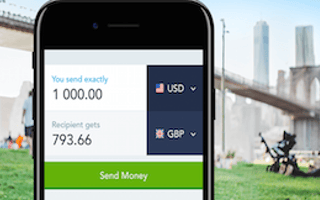
Transferring money abroad is a headache. Most banks and currency exchanges tell you their transfers are free, but often end up charging up to five percent in hidden fees.
TransferWise, a peer-to-peer business that allows people to send money virtually with real exchange rates, wants to change that. The company challenges old-school banking systems in its mission to create a transparent way to send money internationally as fast as possible for as little as possible. Through the company’s app, users can transfer money abroad using the standard exchange rate — not a bank’s — making international money transfers up to 90 percent cheaper in a fraction of the time.
The company launched back in 2010 and has since garnered over one million customers globally. It also received a $1.1 billion valuation last year following a $26 million round. More recently, TransferWise unveiled a Facebook Messenger bot in February, allowing users to send money exchanges and receive exchange rate alerts through Facebook, all without leaving Messenger.
At the core of the unicorn’s success is its technology — and the people behind it. To learn more, we caught up with Riho Taba, Head of Engineering for TransferWise North America, who gave us an exclusive introduction to the tech team making it all happen.
How many people are on TransferWise's engineering team?
We have 130 people on our engineering team, located in seven offices around the globe.
What projects/goals is your team currently working on?
We launched TransferWise for Business about a year ago and are super focused on building an equally great product for small and medium businesses. Businesses are getting ripped off by banks just as much as everyday people. We're excited to start tackling some of the problems they face when operating in multiple countries.
From a tech standpoint, how has your team evolved over the past year?
We have drastically expanded our engineering team over the last 12 months and created regional hubs that give us a more localized presence with teams around the globe.
The greatest learning we’ve had while expanding is the value of autonomous teams. Having ownership segmented by respective regions has had full circle benefits. For example, being less dependent on teams in different time zones allows for faster scaling, better management, personal empowerment and improved project timelines. By the way, we're currently hiring!
What are some of your team's best practices?
We believe that to build a great product, engineers must retain a ‘touch and feel’ for the problems our customers’ face. Our engineers do habitual sessions with customer support to listen in on customer calls or help respond to email inquiries. What we are creating impacts real people and talking to them helps us foster a deeper sense of responsibility.
Also, when projects and features are released to the public, the learning has only just begun. We delve into data on a daily basis to monitor how people are using the features. The product should always be improving.
How would you describe the culture of your engineering team?
Even as teams work autonomously, we all have a shared goal of building ethical technology. For example, we are more concerned with fair pricing than profitability. We believe in passing savings along to our customers whenever there is opportunity and have done this for more than twenty routes over the past year.
We also want to encourage big thinking. To do this, we have to make sure that people aren’t afraid to challenge themselves. So, we instituted “shameless post mortems.” They go to the entire company and explain what went wrong, key learnings, and how we are modifying processes moving forward. They encourage teams to share their learnings so that everyone can benefit from the experience.
How does the engineering team collaborate with other teams in the company?
Feedback is a really important part of our culture, so TransferWise engineers don’t work in isolation from the rest of the company. We involve customer support, payment operations, compliance, and marketing into the process.
There are company-wide initiatives that helps us do this. Teams across the company host monthly sessions to share updates and learnings. We also hold quarterly feedback sessions for teams to discuss plans and ensure that we are prioritizing projects for the right reasons. It’s incredibly helpful to get insights from every market and from all aspects of the business. We believe our success comes from this inclusion as the collaboration allows our teams to be more efficient.




